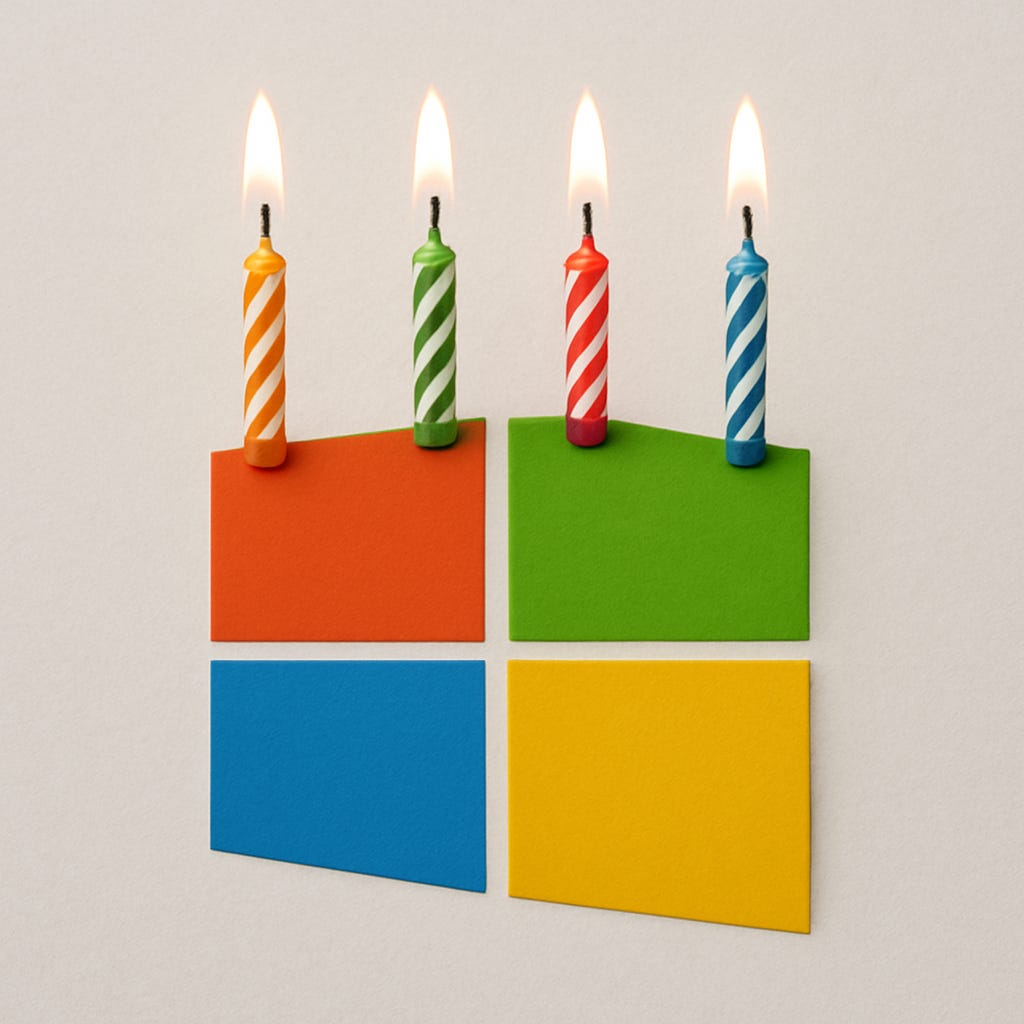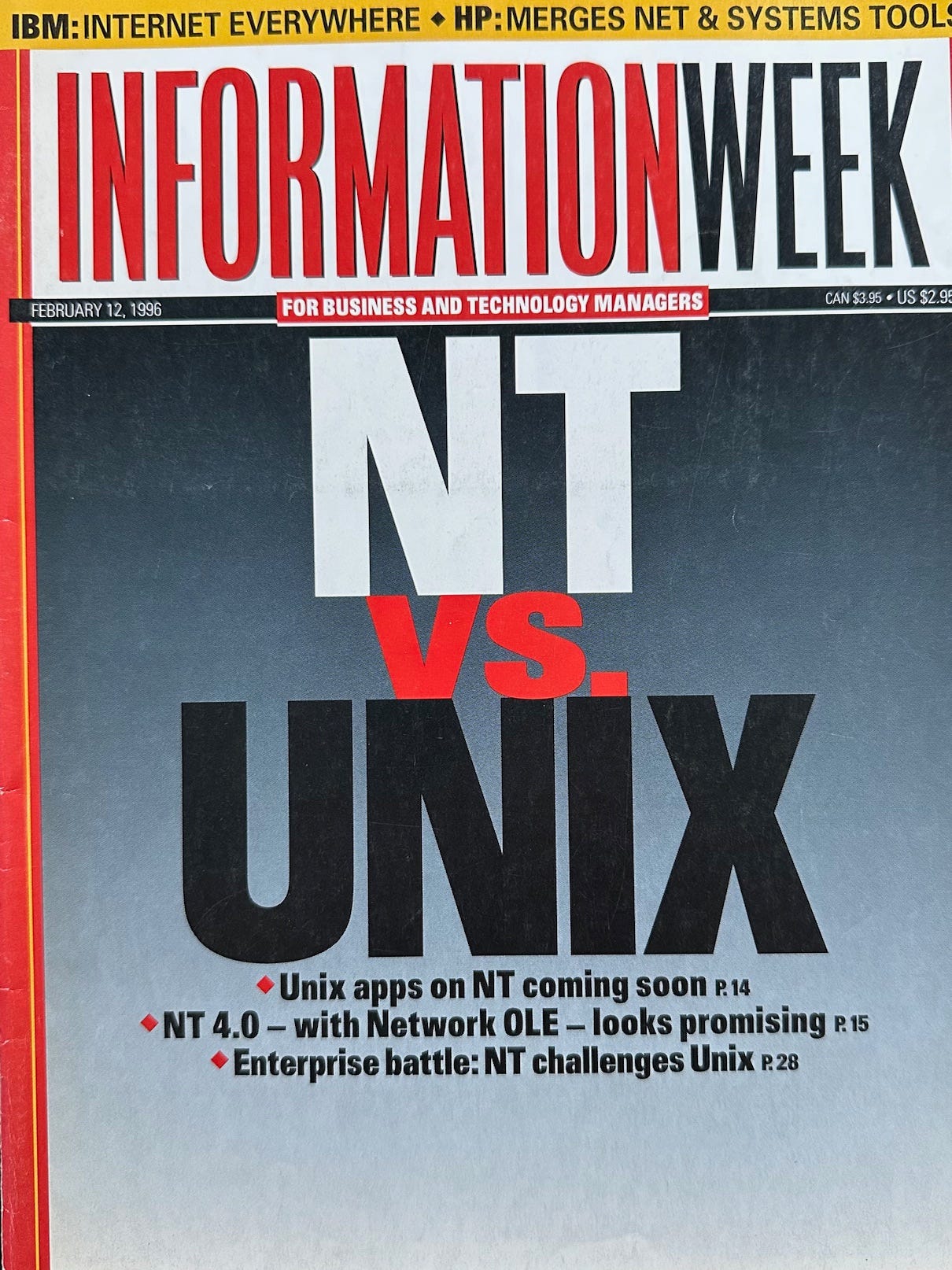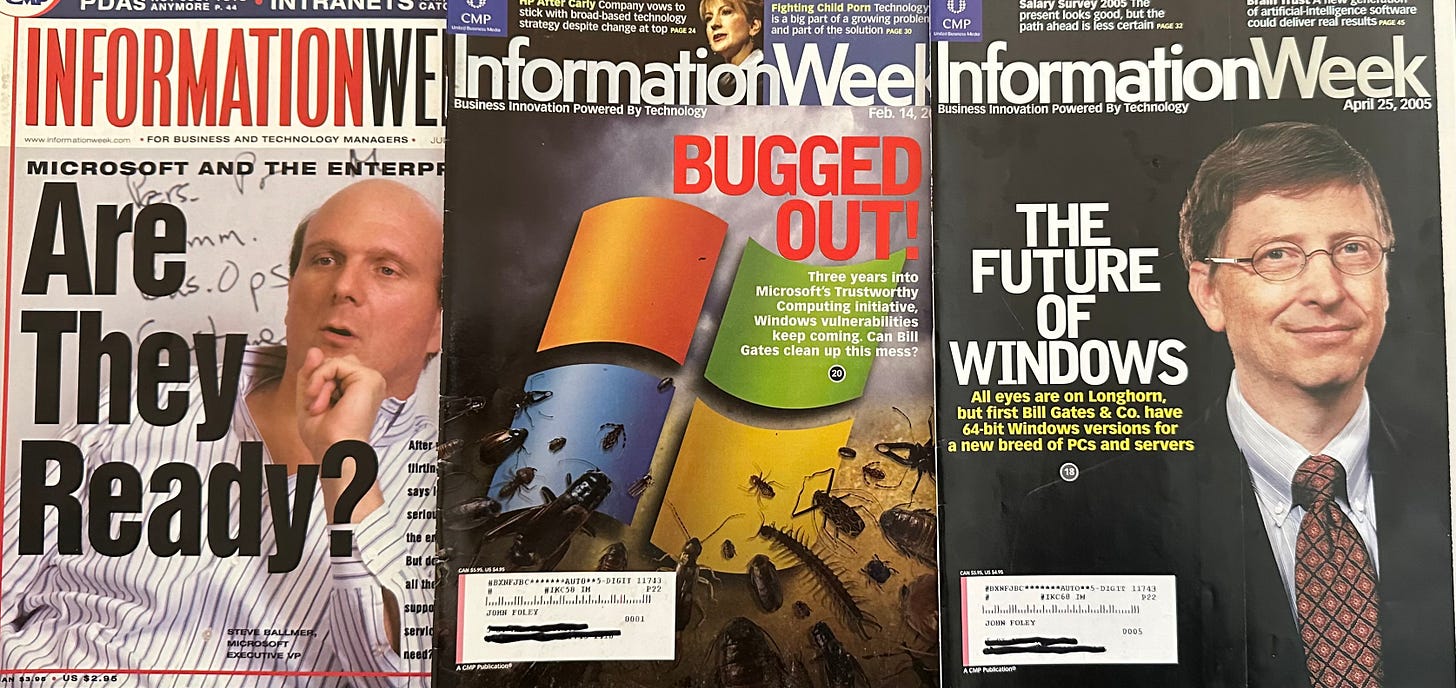Microsoft's Rise in the Enterprise: My Conversations with Bill Gates, Steve Ballmer, and Satya Nadella
On Microsoft's 50th anniversary, these are some of the most memorable moments from my reporter's notebook.
Welcome to the Cloud Database Report. I’m John Foley, a long-time tech journalist, including 18 years at InformationWeek, who then worked in strategic comms at Oracle, IBM, and MongoDB. I invite you to subscribe, share, comment, and connect with me on LinkedIn.
This post, on Microsoft’s 50th anniversary, is for posterity. As a tech journalist who’s been covering Microsoft since the mid-1990s, what follows is a recounting of the highlights and yes a few lowlights.
I’ve had the good fortune of meeting and interviewing each of Microsoft’s CEOs. I talked to Bill Gates at least a half-dozen times, had lively conversations with Steve Ballmer, and engaged Satya Nadella as a VP working his way up the ranks. I’ve talked to dozens of Microsoft product managers and execs, including Jim Allchin, Bob Muglia, Jim Gray, Deborah Willingham, and many others.
If I had to sum up Microsoft’s transformation in a few words, it would be this: The evolution from PCs to enterprise IT to hyperscale cloud. And now AI.
Microsoft undertook a monumental development effort to build its enterprise capabilities: Windows Server, SQL Server, Exchange, System Center, Office 365, Visual Studio, Fabric, Power BI, Dynamics, Azure. Making its way from the desktop into the data center has been the common theme in most of my reporting, going back to the first time I interviewed Gates at Computer Associates’ CA World conference in hot New Orleans, in August 1996, where Microsoft and CA partnered on enterprise management.
Windows NT vs. Unix
One of Microsoft’s most disruptive transformations was its drawn-out shift from proprietary software to open software.
Few people may remember how Microsoft was able to position and even disguise Windows NT as Unix-like operating system in the early days. In 1996, I reported that the company was pursuing billions of dollars in federal IT contracts that called for Unix. To qualify for the RFPs, Microsoft added a Unix-compatible subsystem, developed by Softway Systems and called OpenNT, to Windows NT.
Voila! Windows NT had been transformed into Unix, or close enough. Microsoft later acquired the tech behind it. Here’s the press release.
Windows vs. Unix/Linux provided lots of drama. As part of its move into the data center, Microsoft was trying to establish Windows NT and its SQL Server database as enterprise-class systems that were on par with established computer systems like IBM AIX, HP-UX, and Sun Solaris.
For many CIOs, this was not an either/or decision. They required interoperability between Windows and Unix/Linux, and Microsoft had been slow to deliver. At least that was a view shared by many, but Gates didn’t want to hear it. He pushed back when I asked him about it.
“Tell me any area we’re not doing enough,” he huffed in November 2003 during a one-on-one interview in Las Vegas. “I mean, seriously, what area do you think we could do more in?”
For more on this, see: “Microsoft’s Linux Support: Denial, Then Concession.”
For the record, I wasn’t a newbie asking Gates about Linux. Prior to InformationWeek, I was a reporter for Open Systems Today, where I covered Unix. It was there that I wrote about a startup called RedHat that had released Enterprise Linux 1.0. So I knew the market.
Scaling NT and SQL Server with Cyberbricks
Microsoft got me thinking about data scalability. It started when I met Microsoft research Jim Gray, a Turing Award winner, at an industry conference where he was speaking on “cyberbricks,” his way of explaining how modular, Intel-based technologies could be used to used to build high-scale systems, one x86 brick at a time.
Gray told me of a project to aggregate data to demonstrate that Windows NT and SQL Server could support data center workloads. He needed a terabyte of data, which is laughable by today’s standards but seemed like a lot at the time. As I recall, he used aerial imagery from Microsoft’s TerraServer database to get the big data he needed.
That effort led to a mostly forgotten but in my opinion historic demo by Microsoft: Scalability Day on May 20, 1997, in New York City. You can read about it in the post below.
Tragically, ten years later, the brilliant, much-admired Jim Gray was lost at sea when his sailboat disappeared on a solo voyage to the Farallon Islands, where he had gone to scatter the ashes of his mother. An interesting footnote is that Gray had been a mentor to AWS CTO Werner Vogels, going back to Vogels’ days in academia.
9 memorable moments
Over the years, I made many visits to the Microsoft campus and attended conferences, events, and press and analyst briefings. Often I collaborated on the reporting and editing with some of my wonderful InformationWeek colleagues: Bob Evans, Stephanie Stahl, Rob Preston, Chris Murphy, Charles Babcock, Aaron Ricadela, Stuart Johnston, John Soat, Nick Hoover, and others.
Here are a few noteworthy anecdotes.
1996 - Bill Gates and Scott McNealy weren’t true archenemies. In January of 1996, I was on Sun Microsystems’ campus for a day of interviews with Sun’s CEO, CFO, and CTO. This was at the height of the Sun vs. Microsoft wars, and speculation at the time was that Sun was negotiating to acquire a weakened Apple. McNealy, however, was relaxed and eating frozen yogurt during our interview. His first son, Maverick, had been born a few months earlier, and McNealy went to a corner of his office to get something to show me. It was a hand-written note from Gates congratulating him the new arrival. I reported back to the InformationWeek newsroom that I didn’t see any signs of an imminent deal with Apple and, sure enough, it never happened.
1996 - “The grass is always greener in Redmond.” I wrote that lede to a news story in July 1996 when, during a campus visit, I observed a landscaping crew spraying the ground with biodegradable fertilizer that turned the grass a deeper shade of green. The InformationWeek cover headline — “Are They Ready?” — was a recurrent theme at the time. During our interview, Ballmer pointed to several key areas where Windows NT needed to bulk up, including search, replication, clustering, event management, and transaction processing — in short, much of what was needed for enterprise computing.
1999 - “We have to continue to remake ourselves to be relevant.” That was Ballmer one quarter before the scheduled release of Windows 2000. He had recently overseen a re-org to focus on four constituencies: developers, IT pros, knowledge workers, and consumers. The objectives of the IT group: “The first is reliability—reliability and availability are not exactly the same thing, but they’re kissing cousins—and manageability,” Ballmer said. “You could say they have a focus on scalability too, and that’s true, but most of the scalability solutions come by improving the tool, so the applications themselves are designed to be almost infinitely scalable.” In hindsight, with the cloud/SaaS model on the horizon, it was a prescient comment.
2002 - Bill Gates once gave Microsoft’s software the lowest possible rating. In May 2002, a few weeks after Gates’ famous Trustworthy Computing memo, my colleague Chris Murphy and I interviewed Gates for more than an hour in New York. I mention the length of the interview to make the point that Gates could be generous with his time. Towards the end of the interview, we asked him to rate Microsoft’s overall software quality on a scale of one to 10. Here was his surprisingly frank response.
InformationWeek: On a scale of one to 10, where one is unsatisfactory and 10 is high satisfaction, how would you rate the overall software quality of your company’s products today?
Gates: It’s a very subjective number. I mean, is it as good as people want? One. Is it good compared to other people’s software or what we were doing three or four years ago? I'll give us a nine. But it’s the most subjective question in the world, and, hey, the customer is always right. Are they going to rank us any worse on that number now than they did four years ago? No. Are we doing a dramatically better job on this stuff now than four years ago? Yes.
It was a blunt self-assessment, and the right one at the time. For the full Q&A, see “Bill Gates On Trustworthy Computing.”
2003 - Bill Gates dodged only one question I asked him. IT departments were spending hours patching buggy Windows PCs, even after the launch of the Trustworthy Computing initiative. One CIO I talked to threatened to charge Microsoft for the hours of work put in by his staff. I asked Gates whether other business customers were making demands for reimbursement. “Is this something you’re talking to business customers about—somehow taking some of the financial responsibility for the work they’re having to do?” After a long pause, he answered: “We’re very focused on doing our best to avoid these problems. That’s our focus.” It’s the only time he didn’t directly answer one of my questions.
2004 - Satya Nadella managed a project to weave together four ERP suites. As VP with Microsoft Business Solutions, Nadella was tasked with melding four ERP systems into a unified whole, now known simply as Dynamics. The unit had grown following Microsoft’s acquisition of Great Plains in 2000 and Navision in 2002, leaving the company with four application suites: Axapta, Great Plains, Navision, and Solomon. In 2004, the situation was further muddied when Microsoft disclosed it had been in merger talks with SAP (which didn’t happen, of course). One of the objectives of Project Green, Nadella told me, was to establish a more flexible app infrastructure vs. hard-coding functionality for specific processes. “What you need is an upgradeable and customizable system,” he said. “Today, it’s either/or.” Gates, in an interview, once sketched out the rough architecture for me with pen and paper.
2005 - Bugged Out! In one of the boldest, and grossest, covers that InformationWeek ever published, the design team overlaid the Windows logo with centipedes, roaches, beetles, and earwigs (see above). My cover story, timed with the RSA conference, noted that Microsoft had just released a dozen security bulletins addressing 17 software vulnerabilities. That was three years into Trustworthy Computing, yet, as the magazine said in big type, “the bugs keep coming.” We acknowledged that the company was making progress with more secure software and a patching schedule. But as a spokesperson admitted, “Ultimately what matters is not what we say, but what we do.”
2005 - Bill Gates’ mind like a calculator. I saw it in action when, during an interview in Redmond, Gates walked me through the evolution from 16-bit to 32-bit to 64-bit computing. The occasion was the launch of 64-bit Windows, and Gates was talking me through the advances in microprocessor design over the years. He started with the premise that the IT industry had been gobbling up about 1 bit of memory address space per year, resulting in a need for ever more address space. During the interview, Gates came to the realization that the industry was consuming address space at nearly double the rate of the past. (My original article, if you can find it, was headlined, “A Trip Down ‘Memory Lane’ With Bill Gates.” Unfortunately, some of the InformationWeek content I authored no longer turns on in search.)
2008 - Gates retired five years earlier than planned. It’s an obscure fact, but true. In August 2003, in a luncheon speech at the Detroit Economic Club, Gates said he had “a little more than 10 years” left in his software career. That would take him to 2013. However, three years after that speech, in 2008, Gates surprised the business world with the announcement of his retirement, a full five years earlier than indicated. New York Times reporter John Markoff caught this discrepancy. It was the first question Markoff asked at the press briefing, but Gates said he didn’t recall his earlier statement, and the subject was dropped.
Epilogue
Microsoft has largely accomplished what it set out to do in the enterprise. The company’s revenue has grown from $6 billion when I started covering it in 1995 to $246 billion in FY24, an annual growth rate of about 14%. It’s well established as an IT platform provider and is among the world’s three largest hyperscalers, along with AWS and Google Cloud, with more than 300 data centers around the world.
Even so, Microsoft’s current challenges are hyperscale in size, too. It’s AI and copilot strategy has experienced fits and starts. Security is a never-ending concern. And it’s reportedly putting the squeeze on underperforming employees, a tacit acknowledgement of the need for improvement in its ranks.
But I give Gates, Ballmer, Nadella, and the rest of the gang their due. After 50 years of product dev, antitrust wrangling, cyber scares, and zigzagging on AI, Microsoft is one of the most valuable companies in the world, with a market cap of around $3 trillion.
However, the milestone celebration is over. You can’t have your anniversary cake and eat it too. Now, it’s about the next 50 years.
Additional reading
“A Day In My Life, By Bill Gates,” InformationWeek, March 4, 2003
“Bill Gates Discusses 64-Bit Windows, Longhorn Transition,” InformationWeek, April 25, 2005








